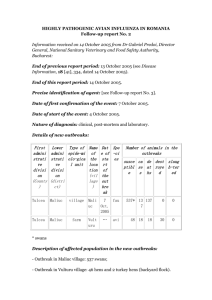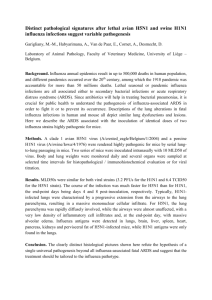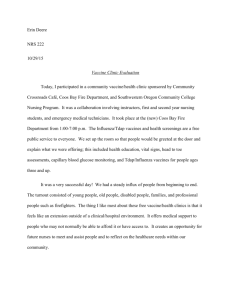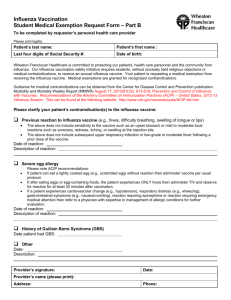vaccine use
advertisement
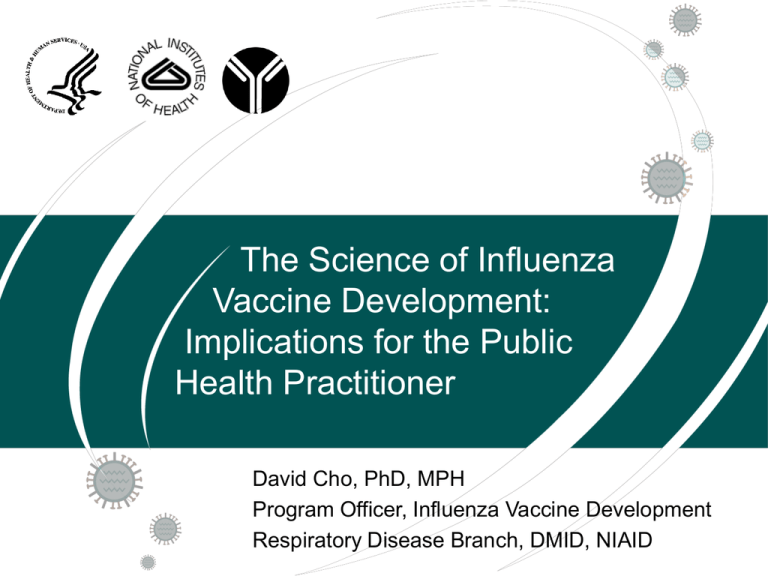
The Science of Influenza Vaccine Development: Implications for the Public Health Practitioner David Cho, PhD, MPH Program Officer, Influenza Vaccine Development Respiratory Disease Branch, DMID, NIAID Goals of the Presentation Describe the basic scientific differences between seasonal and pandemic influenza Explain what researchers are doing to overcome the challenges that a pandemic strain brings Explain what practitioners should consider in preparation for a pandemic Characteristics of a Pandemic Influenza Virus Influenza A virus with a novel hemagglutinin or novel hemagglutinin and neuraminidase in man Susceptibility (no neutralizing antibody) to the novel virus in a large proportion of the population Demonstration of the virus to cause and spread person-to-person in a sustained fashion Influenza Virus Nomenclature Source: Subbarao/Murphy Clinical Burden of Influenza Virus Morbidity and Mortality Previous pandemics 1918 H1N1 transferred from birds?: > 40 million deaths worldwide 1957 H2N2 avian- human reassortant: > 2 million deaths 1968 H3N2 avian- human reassortant: > 1 million deaths Seasonal influenza Millions of human cases; hundreds of thousands of hospitalizations yearly in the US alone Influenza and pneumonia: 7th leading cause of mortality in the US in 2002 20,000 to 40,000 deaths annually US 250,000 to 500,000 deaths annually worldwide Clinical Burden of Influenza Virus Morbidity and Mortality (continued) H5N1 Avian influenza Seasonal influenza Millions of human cases; 290+ documented hundreds of thousands of human cases hospitalizations yearly in the 170+ deaths US alone Influenza and pneumonia: 7th Over 3 ½ + years, fewer leading cause of mortality in than 100 documented the US in 2002 cases/ year 20,000 to 40,000 deaths annually US 250,000 to 500,000 deaths annually worldwide Cumulative Number of Confirmed Human Cases of Avian Influenza A/(H5N1) Reported to WHO 11 April 2007 Country cases deaths Azerbaijan 8 5 Cambodia 7 (1) 7 (1) China 24 (2) 15 (1) 1 0 Egypt 34 (16) 14 (4) Indonesia 81 (6) 63 (5) Iraq 3 2 Lao People’s Dem Rep 2 2 Nigeria 1 1 Thailand 25 17 Turkey 12 4 Viet Nam 93 42 291 172 Djibouti Total > 50% mortality Cases and countries shown in gold for events since January 2007. WHO reports only laboratory-confirmed cases. H5N1 outbreaks in 2005 and major flyways of migratory birds (situation on 30 August 2005) Mississippi Americas flyway East Atlantic flyway Atlantic Americas flyway Black Sea/ Mediterranean flyway Districts with H5N1 outbreaks since January 2005 Pacific Americas flyway East Africa West Africa flyway Central Asia flyway East Asia/ Australian flyway Sources: AI outbreaks: OIE, FAO, and Government sources. Flyways: Wetlands International Schematic Version of Influenza Virus (continued) Influenza A subtypes: 16 Hemagglutnins (HA) 9 Neuramindases (NA) All subtypes: endemic in birds H1N1, H2N2, H3N2: endemic in people HA trimers: Binds sialic acid and fuses viral and cell membranes NA tetramers: Removes sialic acid to prevent adherence to self or cell during budding Schematic Version of Influenza Virus (continued) RNA Polymerases (PB1, PB2, PA) attached to each RNP Nucleoprotein (NP) binds RNA and Matrix protein (M1) On viral and infected cell surface: M2 tetramers Hydrogen ion channel In infected cell: NS1 Binding host proteins Role in IFN resistance Emergence of New Human Influenza Subtypes H5N1 Virulence Factors in Mammals HA with multibasic amino acid motif (RERRRKKR) at the HA1-HA2 cleavage site Polymerase genes adapted to mammalian host 1997 H5N1 with PB2 lysine at AA position 627 2004 H5N1 with polymerases from human source more virulent in ferrets than same H5N1 with polymerases from avian source NS1 gene adapted for mammalian host Inhibition of interferons Increased TNF alpha Source: Salomon et al. JEM 2006;203:689. What Makes the HA Highly Pathogenic? Source: Horimoto and Kawaoka. Nature Reviews Microbiology, 2005 Questions? Common Features of H5N1 in Humans Contact with sick/dying poultry Frequently healthy young person Average age <18 Incubation period 2–4 days from probable exposure Presenting symptoms fever, dyspnea, cough Diarrhea more common than expected with influenza Leukopenia/lymphopenia/thrombocytopenia Metabolic abnormalities Common Features of H5N1 in Humans (continued) High frequency of progressive pneumonia Mostly primary viral Occasional contribution of bacteria? • (Staphylococcus aureus and Haemophilus influenzae) Hepatic necrosis and acute tubular necrosis High mortality rate in spite of antiviral/steroid/antibacterial treatment Common Features of H5N1 in Humans (continued) Diffuse activation of the innate immune system (“cytokine storm”) with increased levels of: Interleukin 1 beta Interleukin 6 Interleukin 8 Tumor Necrosis Factor alpha Interferon alpha Interferon gamma Interferon inducible protein 10 Soluble Interleukin 2 receptor Monocyte chemoattractant protein 1 Chest Radiographs of Patient with Severe H5N1 Influenza Pneumonia: Vietnam, 2004 Source: Tran et al. N Engl J Med 350:1171, 2004 Additional H5N1 Virulence Factors in Humans HA receptor binding Two ketosidic linkages of sialic acid to galactose: alpha 2,3 and alpha 2,6 Avian HA preference for alpha 2,3 linkage Human upper airway predominantly alpha 2,6 linkage Human lower airway more abundant in alpha 2,3 linkage Possibly contributes to the high incidence of primary viral pneumonia caused by H5N1 viruses Source: Shinya et al. Nature 2006;440:435 Evidence for Person-to-Person H5N1 Transmission (Not Sustained) Possible instances of infection of health care workers during 1997 outbreak in Hong Kong Family clusters Vietnam, Thailand* and Indonesia** Cluster in Indonesia suggests human to human to human transmission before the chain extinguished*** (* Ungchusak et al. N Engl J Med 2005;352:333-340 ** Kandun et al. N Engl J Med 2006;355:2186-2194 ***Normile Science 2006;312:1855) Detection of H5N1 Viruses: Lessons from Recent Experiences Throat samples may give higher yield than nasal samples, but both worth examining Rapid tests poor negative predictors and lack specificity But microarray methods improving and may provide sensitivity and specificity Polymerase chain reaction (PCR) increases sensitivity but success depends on the primers used for amplification Laboratory confirmation generally accepted Viral culture Positive PCR for H5N1 RNA • (see www.cdc.gov/mmwr/preview/mmwrhtml/mm5505a3.htm) Positive immunofluoresence using a monoclonal antibody for H5 4-fold or greater rise in H5-specific antibody in paired acute and convalescent sera Questions? Antiviral Therapies for Influenza Antiviral Agents for Treatment of H5N1 Viruses Early treatment recommended for suspect cases but efficacy, optimum dose, and duration uncertain Treatment of choice is a neuraminidase inhibitor Oseltamivir has been most frequently used • 5 days treatment of 75 mg twice daily for adults and dose decreases for children dependent on body mass is standard • Higher doses may be considered by some authorities but no prospective studies Oseltamivir resistance during treatment may not result in resistance to zanamivir Antiviral Agents for Prophylaxis of H5N1 Viruses Oseltamivir 75 mg once daily for 7–10 days may be considered for significant post exposure prophylaxis But rationale is based on evidence from studies with other influenza A virus subtypes Potential recipients would be poultry workers/cullers, health care workers, household contacts Antiviral Agents for Treatment of H5N1 Viruses Zanamivir administered as inhaled powder, which may be difficult with respiratory symptoms Amantadine/rimantadine resistance common in Asian H5N1 viruses Possibly from agricultural use of drugs Amantadine/rimantadine susceptibility of some recent strains (African/European/Middle East) May be clade specific May be a role for M2 inhibitors Other drugs (ribavirin and interferon) may also be considered but no value clearly documented Clinical studies in progress Peramivir (injectable neuraminidase inhibitor) CS8958 (once daily neuraminidase inhibior) 705 (polymerase inhibitor) Studies may start soon with FluDase (sialidase to remove viral receptors) Pandemic Influenza Preparedness: Complementary Roles Within DHHS NIH Trials with sanofi pasteur H5N1 A/Vietnam/1203/2004 Adults (18 – 64y; 7.5, 15, 45, 90ug)* Immune response observed at all dose levels after a single dose, unadjuvanted vaccine 2 x 90mcg doses produced most frequent and highest antibody responses April 17, 2007 FDA approval of sanofi vaccine at 90 mcg dose for persons exposed to H5N1 Additional studies in elderly (65y+; 45 or 90ug); children (2–9y; 45ug) Immunogenicity results similar to adults (* Treanor et al. N Engl J Med 2006; 354:1343-1351) Dose Optimization of Inactivated H5N1 Vaccines: Aluminum Adjuvants Controlled trials completed or planned CSL Australia: subvirion vaccine +/- AlPO4 Baxter Austria: whole virus +/- AlOH Novartis UK: subunit vaccine +/- AlOH Sanofi France and US: subvirion vaccine +/- AlOH in adult and elderly populations Summary Vaccines well tolerated with or without aluminum adjuvant Immunogenicity: Aluminum adjuvants do not show a clear advantage over vaccine alone Dose Optimization of Inactivated H5N1 Vaccines: Other Adjuvants Trials with other adjuvants GSK: subvirion vaccine +/- AS (proprietary adjuvant system) Novartis UK: subunit vaccine with MF59 (proprietary adjuvant system Summary Vaccines well tolerated with or without adjuvant but somewhat increased local reactogenicity Immunogenicity: Adjuvants result in more frequent and higher antibody responses Dose Optimization of Inactivated H5N1 Vaccines: Route Trials with other alternate route of administration Sanofi subvirion vaccine given intradermal (ID) at reduced dose or intramuscular (IM) at higher dose Summary Vaccines well tolerated but increased local reactogenicity with intradermal administration Immunogenicity: High doses IM more immunogenic than lower doses ID Additional studies planned for better direct comparison of same dose given ID and IM Source: The WHO Global Influenza Program Surveillance Network Keeping up with H5N1 Drift: Vaccine Reference Virus Efforts Underway Clade 1 vaccine; trials underway Vaccine candidates: A/VN/1203/2004 and A/VN/1194/2004 Clade 2 - subclade 2 candidates available; vaccine production ongoing CDC: Indonesia/05 (Sanofi US; DHHS) NIBSC: A/Turkey/Turkey/1/05 St. Jude: A/BHG/Qinghai Lake/1A/2005 and A/WS/Mongolia/244/05 Clade 2 - subclade 3 candidates in development CBER/FDA: A/Duck/Laos/3295/06 CDC: A/Anhui/1/2005 St. Jude: A/Japanese White Eye/HK/1038/06 Questions? What Can We Expect of H5N1 Influenza? Since 2003, increasing number of countries in Africa, Asia, and Europe have documented H5N1 virus in poultry or migratory birds. Continued H5N1 evolution, possibly amplified by uncontrolled transmission in high-density poultry. Human cases track exposure to infected poultry and are accelerating in frequency. Clusters and potential human-to-human spread plus epidemic influenza provide continuing chance for reassortment. Hong Kong model for eliminating infected poultry and preventing human illness Agricultural surveillance and action are critical early steps. Enforcement of market sanitation. Poultry segregation (quail as asymptomatic carriers eliminated). Vaccination with agricultural vaccine (asymptomatic infections possible). Difficult to implement because of social and economic concerns. Annual Influenza Vaccine Production Bulk vaccine production Millions of chickens Global surveillance (ongoing) WHO strain selection Manufacturers assess growth & yield of candidates Antigenic relatedness confirmed Sheep sera FDA potency reagents Millions of fertilized eggs PHS strain selection Purified HA Standard antigen ~1 rooster for 10 hens FDA approves supplement to license Coordinated collaborative & complex! Filled into vials/ syringes Formulated lots Generation of high yield reassortants “candidates” ? Demand Distribution/ vaccine use ? Severity of Season ? Recommendations FDA release testing Influenza Vaccine Production Timeline U.S. Seasonal Influenza Vaccine: Production and Use Beyond Eggs and Cell Culture: Research Efforts to Develop New Technologies Goal: Develop “agile” vaccine platforms DNA Plasmids – single or multiple gene combinations (HA + NP + M2); conserved regions; single subtype or multiple subtypes (H3 + H1 + H5) Vector Adenovirus, alphavirus, salmonella strains Recombinant subunit Expression systems, baculovirus, drosophila Peptide vaccines Synthesized multigenic peptides Vector-based vaccines Influenza Virus and Protein RNAs: Targets for a “Universal Vaccine” Source: Subbarao/Murphy Seasonal Influenza Preparedness Pandemic Influenza Preparedness


